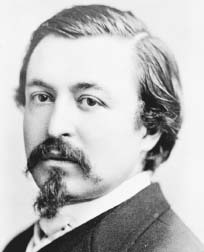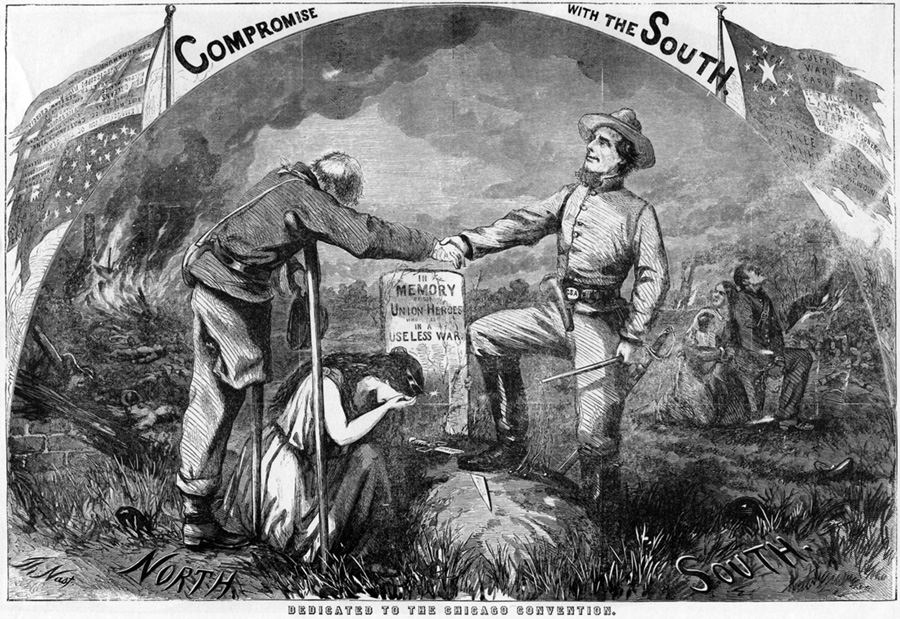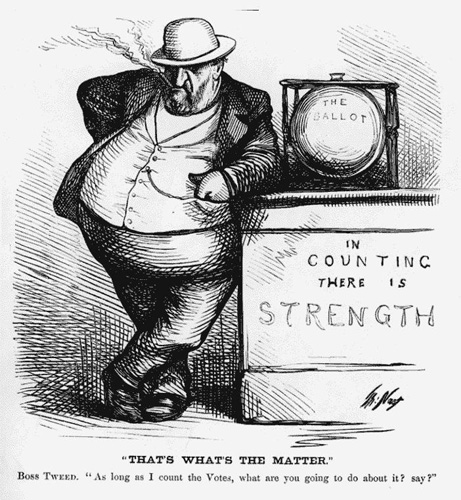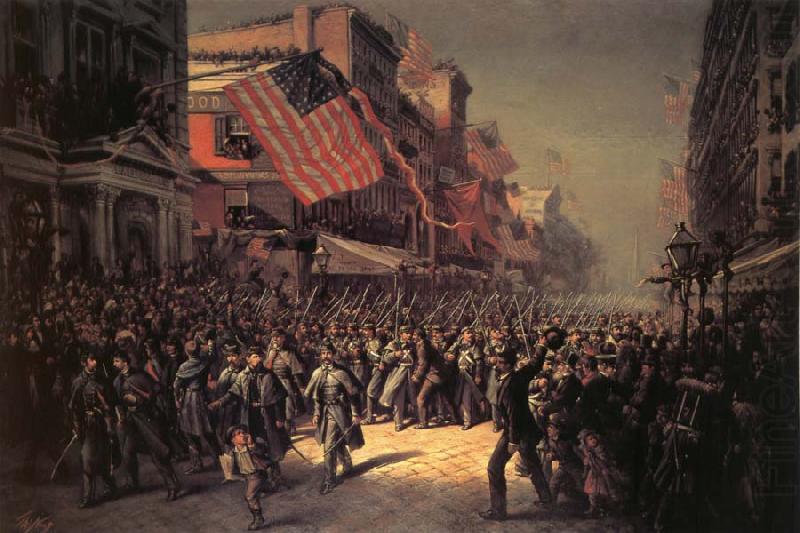Essay: Thomas Nast by Eleanor Smith
| "Öhe has been called, perhaps not with
accuracy, but with substantial justice, the Father of American
Caricature"; so states Thomas Nastís 1902 obituary
in the legendary Harperís
Weekly. Few cartoonists have influenced American politics,
sentiments, pop-culture, and opinion as have the drawings of
Thomas Nast. A constant in shaping the American way of life,
Nastís cartoons and drawings are as well-known today as in the
late 1800ís when they were at the height of their reign. Beginning
with the Civil War, Nast and his art played a crucial role in
molding the history of this nation. From influencing vital elections
to bringing justice to the corrupt "Boss" Tweed to
publishing radically liberal sentiments to popularizing our
modern day Santa Claus, Thomas Nast defined an era. There are
many reasons for his popularity and longevity in his field.
Nast was a smart liberal with strong views who worked hard to
position himself in a place where he could communicate to the
American public. Aside from these factors, however, Nast was
an amazingly talented artist. With the marrying of great artistic
abilities and a strong sense of the American way, Nastís drawings
are just as relevant and educational today as they were when
he first published them. |
 Thomas Nast
Thomas Nast |
Born in Landau, Germany in 1840, Thomas and his
mother moved to New York City in 1846 with his father coming
along a few years later. Nast first studied his love of art
at the age of 14 with Theodore
Kaufmann and the next year began work at the Thomas
Jefferson Bryan Gallery of Christian Art. At the young
age of 15 Nast was hired as a reportorial artist for Frank
Leslieís Illustrated Newspaper and then in 1859 moved
to the New
York Illustrated News. Throughout this time Nast was
working solely as a reportorial artist. He would be sent out
on assignments, recreate what he saw, and then send his drawing
back to the papers. Once back at the paper, Nastís drawings
were transferred to wood engravings there were then printed
as a two page spread. "He drew backwards directly on
the boxwood printing blocks with a soft pencil. His heavy use
of cross-hatching provided tonality for the back and white drawings"
(www.lib.ohio-state.edu). Wood
engravings were immensely popular in this day. In 1862, Nast
had quite a bit of freelance work behind him and this soon developed
into a position at Harperís Weekly. From here, his real
career began as he was able to draw freely and reach a wide
audience. |
|

"Thomas Nastís first opportunity to
influence American sentiment came with the Civil War. His
commentary on that struggle is an evocative record of its
development into a contest between opposing ideologies. At
the same time, his work contributed largely to the appearance
of a Northern sentiment that made the preservation of the
Union and the end of slavery inseparable causes"
(Keller 11). As expected, Nast
was a ferocious supporter of the Union and his drawings depicted
this to no end. It was also during this time that Nast was
able to really achieve strong credibility in the world of
political cartoonists. The popularity of many drawings attests
to this credibility but one in particular stands out. Published
in Harperís Weekly on September 3, 1864 the drawing
entitled "Compromise
with the South" is deemed to have brought Nast
instant fame. The drawing shows "ÖColumbia weeping
at the grave of 'Union Heroes in a Useless War' " as a
weary Union amputee shakes the hand of a neatly groomed Southern
soldier" (www.lib.ohio-state.edu).
It is my opinion that the popularity for these
Civil War era drawings came about on many fronts and for many
reasons. As stated, Nast was beautifully talented as an artist.
However, these drawings evoke emotion, for they tell a story.
In most of them there isnít just one thing going on. There
is a central figure or picture with words and other drawings
and stories surrounding it. This technique makes it an easy
scene to follow while also giving the "reader" a
good amount of information without being overbearing. Because
of this technique, Nastís drawings could reach a wide demographic
and people of all educational backgrounds could discern something
of his meanings.
|
| Although this talent of reaching a wide demographic
was a positive thing for Nast and his popularity, there were
those that were affected negatively by this gift, namely "Boss"
Tweed. Ruling Tammany
Hall and New York City from 1866 to 1871, William
M. "Boss" Tweed and his band of politicos
made the Tweed
Ring a corrupt addition to an already corrupt city.
Nast and Tweed clashed on every level imaginable. "Tweed,
then, was Thomas Nastís political antichrist for an interlocking
set of reasons" (Keller 179).
Tweed, an Irish-Catholic and Nast a Protestant, Nast a Republican
and Tweed a Democrat, Nast a morally committed political satirist
and Tweed a corrupt politician out for personal gain, the two
were obviously destined to never be friends. Nast led an attack
against Tweed and his Ring with the help of his employer Harperís
Weekly and the famed New
York Times. Indicting Tweed on counts of "massive
contract padding and other Ring frauds" (Keller
180) led to two years of court trials and a final
sentencing of twelve years in prison for the Boss. Though he
would never return to power, Tweed escaped from jail, hid in
New Jersey, then in Spain, and was finally caught and again
put in prison. During the time of his reign and Nastís attack,
Tweed was documented in saying "Stop them damn pictures.
I don't care what the papers write about me. My constituents
can't read. But, damn it, they can see the pictures"
(www.lib.ohio-state.edu). |
|
 |
Though much of Thomas Nastís work is defined
by its political associations and satires, it is just part
of his complete portfolio. Defining what America today knows
as Santa Claus, Nast has a plethora of Christmas drawings
that may even be more of a testament to his importance than
his political cartoons. " Thomas Nastís book, 'Christmas
Drawings for the Human Race'Öwas published in time for
the 1890 Christmas season. It contained pictures that had
appeared in Christmas issues of Harperís over a period of
thirty years as well as some drawn especially for inclusion
in the book. The five Nast children were used frequently as
models in many of the drawings and many scenes from the Nast
home were incorporated also" ( Nast
St. Hill, vi). Nast took much of his inspiration
from the Clement Moore poem " Night before Christmas".
However, many of his drawings came strictly from his own imagination.
Thomas
Nast St. Hill has said that " Santaís workshop
at the North Pole was also a product of Nastís imagination".
After the success of his published book, Nast spent a great
deal of time painting in oils. Moving away from current
political events and appreciating his strictly artistic endeavors
gave Nast a chance to become recognized for something other
than governmental satire. Though he is still widely known
for his political influences, I would have to say that his
drawings of Santa Claus and Christmas scenes have influenced
a greater majority over a greater length of time. |
|
Though Nast had success in the publishing of his Christmas
book, by 1890 he was not in a healthy place mentally or professionally.
Having left Harperís
Weekly in 1886, Nast saw a decline in his work and
his inspiration that left him depressed. Desperate for work,
Nast attempted to try his hand in oil paintings, most of which
depicted recent American history. Unsuccessful in this, he
accepted a position in Ecuador appointed by President
Theodore Roosevelt and died soon after.
The drawings and cartoons of Thomas Nast were dynamically
influential and important in his day and continue to be so
in the present. Nast was talented as an artist, had quite
an imagination and a fierce political head about him. Without
Nastís work, American history much would be different today.
There may never be a more significant cartoonist.
|

"The Departure Of The 7th Regiment To The War, April 19,
1861", 1869
Works Cited
Keller, Morton. The Art and Politics of Thomas Nast.
New York: Oxford University Press, 1968.
Paine, Albert Bigelow. Thomas Nast His Period and His Pictures.
New York: The Pyne Press Princeton, 1904.
Nast St. Hill, Thomas: Introduction. Thomas Nastís Christmas
Drawings. By Thomas Nast. New York: Dover Publications Inc., 1978.
vi-viii.
Thomas Nast. 2002. The Ohio State University Libraries. 17
July 2004. <http://www.lib.ohio-state.edu/cgaweb/nast/>
Home
- Student Projects - Next
|